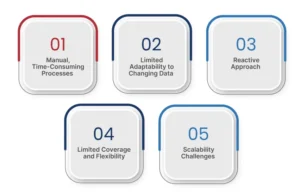Recommended Blogs

Unlocking Trust: How GenAI Elevates Enterprise Data Quality
Table of Content
Data is the fuel of every enterprise, but when it’s inaccurate, duplicated, or incomplete, it becomes a liability. The scale of the problem is massive, poor data quality costs U.S. businessesover $3 trillion annually. On average, organizations lose $15 million yearly to flawed data, while 67% of leaders admit they don’t fully trust their data for decision-making.
That’s the pain: billions wasted, strategies stalled, and trust eroded. The gain? Generative AI offers a new path. Gen AI cleans data and makes it reliable by putting it in context, learning from it, and detecting anomalies. This lets businesses make choices faster, more accurately, and more confidently.
Testing Why Data Quality Defines AI Success
Businesses are testing data quality in new ways with generative AI. Gen AI differs from other AIs because it’s bright, adaptable, and big. Some key parts of this revolution are:
Real-time Anomaly Detection
GenAI brings automated data quality testing to life by leveraging real-time anomaly detection and predictive validation. This surpasses traditional data quality testing methods that rely on static rules. This real-time detection means problems like missing data numbers, duplicate data, or data that doesn’t match are found immediately. This helps to discover operational issues and prevent them from impacting business activity.
Predictive Error Prevention
Gen AI doesn’t just check for errors after they happen; it also looks for problems with data before they occur. Businesses can see where issues will appear in the future by looking at past trends and finding outliers. This allows them to update the data or tell the right people so they can act before operational issues happen.
Automated Data Reconciliation
Gen AI makes combining data from multiple sources easier by automatically detecting and resolving differences. This saves time on manual cross-checking, minimises the risk of human error, and ensures data on different platforms is consistent, correct, and in line with business needs. It also makes data more reliable.
Adaptable to Different Data Types
Gen AI can work with structured data (tables and databases) and unstructured data (text logs, IoT sensor data, and free-form documents). This flexibility allows it to check data from multiple sources, a problem for older systems with dynamic or non-tabular datasets.
Scalability for Large Datasets
GenAI can process millions of records quickly and scale within any data quality testing framework, enabling consistent validation across datasets. Gen AI stays efficient with big, changing datasets because it can learn and adapt as data evolves.
Where Legacy Testing Methods Fall Short
Businesses have been using traditional data quality testing methods for a long time but can’t keep up with today’s fast-paced and complex data environments. Some key limitations are:
Manual, Time-Consuming Processes
Traditional data quality testing uses static scripts and user intervention, which is slow and can produce errors. As datasets get bigger and more complex, it takes too long to review and clean data by hand, which can cause problems and slow down decision-making.
Limited Adaptability to Changing Data
Old school validation systems use rules that don’t change quickly when new data formats, sources, or business needs arise. These rule-based systems don’t work as well as data environments change. They can’t handle new data types or adapt quickly to changing business needs.
Reactive Approach
Businesses that use traditional methods that only identify problems after they happen are at risk of faulty analytics or compliance issues. This reactive approach means firms typically have to deal with the effects of bad data after it has already impacted operations, which costs more and takes longer to make decisions.
Limited Coverage and Flexibility
Traditional validation methods typically examine specific fields or scenarios that are already known. They don’t examine complex data relationships or unstructured datasets. This narrow focus can cause unobvious data problems, especially in systems with multiple sources, where data might be linked or not formatted correctly.
Scalability Challenges
As businesses create more data, old ways of doing things struggle to keep up. Manual validation or semi-automated scripts become less valuable and require more time and resources to keep up. This makes it harder to manage the growing complexity of data flows and slows down data processing.
GenAI Capabilities That Transform Data Validation
Generative AI makes data quality testing intelligent, continuous, and predictive, powering top data quality testing frameworks. It can do more than other statistical methods, so data teams can detect and fix problems before they impact operations.
Some key capabilities are:
Contextual Understanding of Data Relationships
Gen AI doesn’t just check rules; it also understands how different data points relate. It can understand the context in which data is used, so the validation process considers dependencies and doesn’t give false positives. This makes data quality assessments more accurate and reliable.
Continuous Learning and Self-Improvement
Gen AI processes more data and learns from past mistakes and patterns, making its predictions more accurate. It can also learn independently, working with new data sources, formats, and business conditions without being constantly reprogrammed. This makes it more efficient and saves people time.
Predictive Data Correction
Gen AI doesn’t just find mistakes that have already happened; it can also guess what problems may occur based on patterns and trends. It helps avoid expensive operational problems or faulty analytics by pointing out possible problems before they happen and either suggesting fixes or fixing them automatically. This means people don’t have to check the data constantly.
Seamless Cross-System Reconciliation
Data is often stored in multiple places or systems, which can cause problems. Gen AI automates the reconciliation process by comparing records from different sources and fixing any issues without being done by hand. This ensures all the data is the same, reducing the chance of mistakes caused by data entries that don’t match or conflict.
Real-time Monitoring and Validation
Gen AI lets you monitor datasets in real time, looking for errors, inconsistencies, or strange events as they happen. This real-time approach means data is constantly checked and up-to-date, so businesses can fix problems with their data immediately instead of waiting for the usual batch checks that happen periodically.
Balancing Ethical Guardrails with Practical AI Use
Generative AI could change how we test data quality, but essential moral and practical considerations must be considered first. Organisations need to find a balance between innovation and accountability to ensure AI-driven processes are valuable and trustworthy.
Some things to consider are:
Data Privacy and Compliance
Businesses must comply with privacy laws like GDPR and CCPA, as Gen AI models deal with personal data. Data privacy must be maintained throughout the AI model’s lifecycle, protecting personally identifiable information (PII) and ensuring AI operations comply with relevant legal and ethical requirements.
Bias Mitigation and Fairness
AI programs can amplify biases in their training data. To ensure fairness, it’s essential to monitor and correct these biases regularly. Organizations must use bias reduction measures to ensure AI-driven decisions are fair and in line with society and ethical standards and to prevent unfair outcomes.
Transparency and Explainability
Organizations must ensure Gen AI models are easy to understand in order to gain trust. Knowing how the AI decides or finds errors is essential so you can be accountable and follow the rules. Business leaders will trust the system if the AI models are transparent.
System Integration Challenges
For Gen AI to be helpful, it must work with the existing data pipelines, ETL processes, and business intelligence tools. Poor integration can cause errors, inconsistent data, or wasted time. AI must be prepared to improve the existing data infrastructure instead of breaking it.
Ongoing Monitoring and Human Oversight
Gen AI does a lot, but people still need to watch it. Regular checks ensure AI models do what they’re supposed to do, align with the company’s goals, and meet ethical standards. People are always involved, so any flaws or biases that pop up out of the blue are found and fixed quickly.
How TestingXperts Ensures Enterprise-Grade Data Quality
TestingXperts (Tx), one of the leading providers of data quality management, helps organisations unlock the power of Gen AI. We design AI models specific to the data type, offering leading data quality testing services that improve data accuracy and reduce risk. From collection to analysis, we validate end-to-end data, starting with data collection as the critical point for quality validation, ensuring consistent quality checks across structured and unstructured data and minimising errors throughout the data lifecycle.
Our AI-powered testing solutions can scale with your business and still validate data quickly with millions of records or streaming data. Tx also ensures it works with your existing systems, including ETL pipelines and analytics platforms, and follows global rules like GDPR, CCPA, and HIPAA to protect data privacy, security, and transparency.
TestingXperts supports ongoing data quality efforts with leading services in data quality assurance, integrating seamlessly with data governance frameworks.
Conclusion
Data quality is no longer just a back-office job; it’s a must-do for the business. Generative AI changes how businesses check, monitor, and trust their data, making it possible to get insights before they happen, make choices faster, and lower operational risk. Companies that use AI-driven testing get more accurate results and the confidence to expand their analytics, AI models, and business intelligence projects.
TestingXperts helps organizations get the most out of Gen AI for data quality testing by giving them expert advice, scalable solutions, and peace of mind that they follow the rules. Please speak to one of our experts today to learn how to make your data a valuable and reliable resource.
FAQs
Data quality management services, including data quality testing tools, help ensure that enterprise data accuraty, data consistency, and trustworthy. These services span profiling, cleansing, validation, monitoring, and data governance to support data-driven success.
A strong data quality testing framework includes data profiling, cleansing, validation, automation, data governance, and real-time monitoring. These components support scalable, reliable data, and automated data quality testing across diverse environments.
Look for a provider offering the best data quality testing services with AI capabilities, scalability, regulatory compliance, and a reputation for leading services in data quality assurance and seamless integration.
Challenges include data silos, poor integration with data quality testing tools, lack of data governance, evolving compliance standards, and scaling across hybrid environments. Legacy systems often lack support for modern automated data quality testing.
Flawed data impacts analytics, compliance, and decision-making. Data quality testing services help prevent costly errors by using frameworks and tools that maintain clean, accurate, and reliable datasets across the data lifecycle.
Healthcare, finance, retail, telecom, and logistics benefit most. These sectors rely on the top data quality testing frameworks to ensure accurate, compliant, and secure data powering real-time decisions and analytics.
Yes. Clean and consistent data improves training quality and model outcomes. Leading data quality solutions reduce bias, enhance feature data accuracy, and increase confidence in AI and ML predictions.
Yes. When deployed responsibly, cloud-based data quality testing services adhere to GDPR, HIPAA, and CCPA with built-in compliance, encryption, and access controls, ensuring secure and transparent AI validation.
Generative AI enables real-time, automated data quality testing, cross-system validation, predictive error correction, and intelligent data mapping. This transforms traditional processes into leading data quality testing services that scale.
Discover more
Stay Updated
Subscribe for more info




